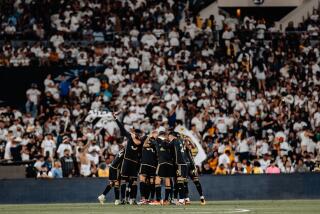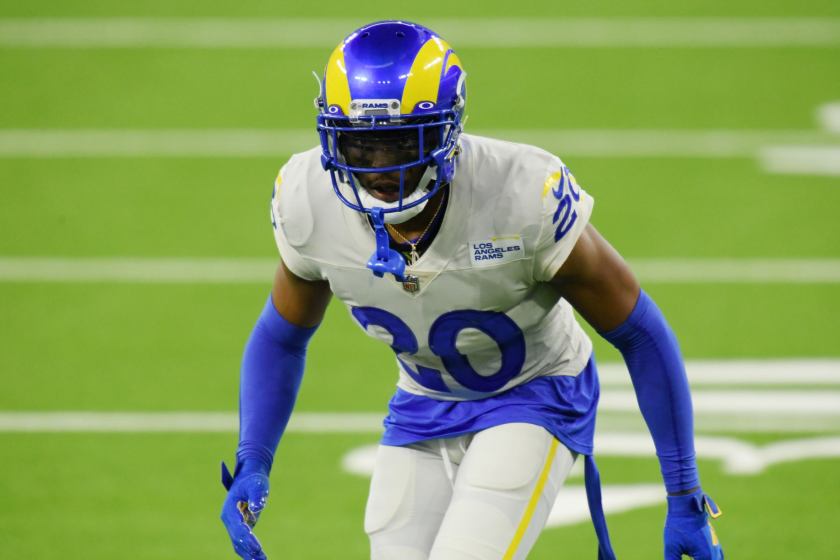PRO FOOTBALL / BOB OATES : L.A. Shrank, Super Bowl Expanded
- Share via
For those recalling that five Super Bowl games have been played in the Rose Bowl, here is today’s quick quiz:
First, name the year when public interest was the largest.
Second, in what year was the crowd the smallest?
Quiet, please, for a moment of reflection.
Ready?
The winner is anyone who answered, “This year.”
The announced crowd for the 1993 game on Sunday, Jan. 31, was 98,374, a low for a Super Bowl at Pasadena, where announced attendance at the first four games averaged 103,038.
And yet, evidence suggests that this year’s game held the attention of more fans than any other sports event in the nation’s history.
“The measure of any event is whether it meets expectations,” David Simon, president of the Los Angeles Sports Council, said recently. “This time, expectations were higher than ever--and still it exceeded all expectations.”
Thus, the TV ratings for Super Bowl XXVII were 45.9 in Los Angeles and 45.1 nationally, indicating an estimated 133.4 million U.S. viewers, the most for a televised event.
Those are Nielsen figures. Assuming they are nearly correct, the crowd at the Rose Bowl should have been larger. Why didn’t it sell out?
“It did sell out,” said Jim Steeg, the NFL’s director for special events. “We counted the seats (before the game) and sold all 98,374.
“The total came in at less than 100,000 because we decided not to use some of the permanent rows. We lost about 1,000 seats for the auxiliary press and another 2,400 seats in the stadium’s bottom rows.
“I doubt if the Rose Bowl has ever actually seated more than about 100,500 for football.
“Our gross crowd might have been 104,000 to 106,000, counting the press and various media persons, concessionaires, vendors, entertainers and various auxiliary personnel.”
The Dodgers, among others, announce both paid and total crowd counts for each game, and the NFL is considering a suggestion that it follow suit next time, when, again, the Rose Bowl’s eight lowest rows will probably remain unused.
“We could sell those seats, of course,” Steeg said. “But down there, in that particular stadium, you have to stand to see the action across the field. And when eight rows stand, there is an (accordion effect). Soon there are 20 rows standing.
“Our tickets were priced at $175 this year. We didn’t think we should charge $175 for standing room only.”
How much resentment did the ticket price provoke?
“There wasn’t much resistance,” Steeg said. “When you think of the Olympics, the World Cup, the best seats at the Indy 500 or Kentucky Derby, our price was in that ballpark.
“It was justifiable, considering the whole production--the NFL’s championship game, plus a pregame show with the Radio City Rockettes and a cast of thousands, plus a Michael Jackson halftime show.”
It went off without a hitch, making Steeg one of the most successful of the nation’s recent sports-event promoters.
For one thing, the foreign press and TV corps numbered 340. Internationally, the game went live to an estimated 750 million viewers.
“The live gate doubled last year’s,” Simon said at the Sports Council office. “The ticket price for the Minneapolis Super Bowl was $150, the crowd was 60,000 and the gross $9 million. At Pasadena this year, with a larger crowd and a $175 ticket, the gross was $18 million.”
After expenses and contributions to various charities, the balance, as usual, will go to the NFL’s 28 club owners.
The Los Angeles economy was another winner. During Super Bowl week, out-of-town visitors left an estimated $180 million here for board, room and fun, according to a survey by UCLA business school researchers.
The pregame projection had been $150 million.
On game day, more than $50,000 was spent on helicopter flights alone.
Sheldon Ausman’s Host Committee, the Los Angeles group that made the Super Bowl XXVII arrangements for the NFL, built a special heliport near the Rose Bowl, where 340 landings and takeoffs were recorded before and after the game.
Which means that between 1% and 2% of the well-heeled commuted by helicopter. Recession, anyone? Not that week.
MULTIPLE-DAY SUPER BOWL
Of the first 26 Super Bowls, most are remembered for landmark incidents during the week of the game. There was, for example, a winter when one of the competing teams found a family of sparrows nesting in its shower room. There was the year that quarterback Joe Namath guaranteed a Jet victory, and another when running back Duane Thomas sat through a long, mass interview without saying a word.
In the histories of pro football, how will this year’s event be identified?
“It will be remembered as the week we shrank L.A.,” NFL Vice President Joe Browne said, noting that the weeklong activities were so compactly arranged that, for the first time, most Los Angeles-area residents seemed to recognize the event’s scope and thrust.
Or as Simon recalled, “The Super Bowl always takes over New Orleans or Miami or Tampa. This is the first time it took over Los Angeles.”
That was shown most vividly, perhaps, in the TV ratings. After hearing and talking about the game all week, most Los Angeles-area residents apparently watched it.
Along with a 45.9 TV rating here, the Los Angeles share was an extraordinary 74. The national share, by comparison, was 66. A Nielsen rating quantifies percentage of TV households tuned to the event. A share is percentage of sets in use tuned to the event.
“The surprise is that the ratings held up that day through a 52-17 rout,” Browne said. “After a 45.5 for Michael Jackson’s half hour, the national rating was still 45.5 during the third quarter, 45.3 in the fourth quarter and 44.8 for the last 19 minutes.”
Los Angeles ratings were 45.3 and 47.3 in the first two quarters, 46.3 for Jackson and 46.6 to 43.2 in the final two quarters.
“L.A. was a big part of the reason for the national Nielsens,” Browne said. “It’s the second-largest TV market.”
Local enthusiasm for the game is also reflected, in part, on a Nielsen list that puts a 1983 “M*A*S*H” special and nine Super Bowls among the 10 most-watched programs ever. First and second on that list are the 1993 and 1986 Super Bowls with 133.4 and 127 million viewers, respectively, followed by 121.6 million for the “M*A*S*H” special.
“The knock against Los Angeles as a major-event site has been that it is too laid back and spread out to get excited about anything, even the Super Bowl,” said Simon. “That was dispelled this year.”
Said Browne: “In the past, our Super Bowl teams have been based up and down the coast from Santa Barbara to Newport Beach.
“We owe a great deal to USC and UCLA. The more compact arrangements this year--the teams were at hotels near their practice sites at the universities--helped make the event work.”
Also making it work was a series of pre-Super Bowl events. For example, there were two Garth Brooks concerts at the Forum.
“Brooks raised about $1 million for Super Bowl charities,” Steeg said. “He had been here during the riots and wanted to be involved in more than just singing the national anthem (at the game). The Brooks concerts sold out within three hours--mostly to L.A. people.”
Another show that extended the one-day Super Bowl into a multiday community event was the NFL Experience. A pro football theme park erected near the Rose Bowl, the NFL Experience attracted crowds totaling 120,000 for the week.
“Kids of all ages got to kick a football or get autographs from NFL players,” Steeg said.
Warren Moon, Steve Young and other players were there to sign.
“For L.A. people, the 1993 Super Bowl was the antithesis of the 1984 Olympics,” Steeg noted. “In 1984, (residents) were told to get out of town during the Olympics. This year we told them, ‘Stick around, and let us entertain you.’ That’s a big part of the reason the game took hold.”
$750 FOR FAMILY OF FOUR
During the week that the NFL shrank Los Angeles, was the Super Bowl as wisely promoted as it seemed?
Some newspaper reporters had their doubts. Among the 2,504 press and electronic representatives were some investigative reporters who, early in the week, seized a helicopter issue to make a point.
They criticized Los Angeles committee people for arranging to transport, free, all 28 club owners and their families via helicopter to and from the game.
That is unbearably elitist, critics observed, and sure to be resented by the common folk down below struggling in heavy traffic.
And it would have been resented. Weeks earlier, however, the plan had been scrapped, Simon reported, as “a bad idea that sounded great for a while--but wasn’t.”
By game week it had become “a red-herring non-issue,” he said, adding that spectators who flew to the Rose Bowl paid their way.
There was also some resistance to the gold, silver and bronze packaging plan that enabled 2,500 preferred spectators to pay from $995 to $1,750 for a $175 ticket and perks.
“Only the gold packages sold out,” Simon said.
That was characteristic of Los Angeles. At Super Bowl I in 1967, when tickets were priced at $12, $10 and $6, only the $12 seats sold out.
“We distributed enough packages to pay all our obligations,” Simon said, adding that the packaging funded the Host Committee budget, which exceeded $3 million.
A final accounting, he said, will be made this spring.
The most pervasive criticism of the Super Bowl again this year was that it’s a rich man’s game closed to all except those who can afford $750 or more for a family of four for tickets, hot dogs and parking; and who, moreover, have sufficient influence to procure the tickets.
Sensitive to all that, the NFL locked into, among other charities, a $2.5-million drive benefiting Youth Education Town in the South Los Angeles area.
“Hopefully, that will assist many young people in that area,” Commissioner Paul Tagliabue said.
The NFL credited Los Angeles’ Host Committee for the smoothness of Super Bowl week.
“It was a near-perfect week,” Tagliabue said.
His events manager, Steeg, said: “The Host Committee handled all the tough problems.”
Among those involved were George Kirkland, president of the convention and visitors’ bureau; John Argue, chairman of the Sports Council, and Pasadena executives Gail Thompson, Bob Holden and Ed Sotelo.
In a full-page ad in The Times on Friday, Ausman identified the 377 other local companies and citizens that cooperated on Host Committee projects. They ranged from Ruth Galanter and Goldie Hawn to Adohr Farms.
Ausman and Simon, who led the campaign that brought in the Super Bowl, are confident that they can persuade the NFL to return twice a decade indefinitely.
Games XXVIII and XXIX are set for Atlanta and Miami in 1994 and 1995. Thereafter, the candidates are Phoenix, Florida, New Orleans and, among other California cities, Los Angeles.
“Will we be back?” Tagliabue said. “You can count on it.”
More to Read
Go beyond the scoreboard
Get the latest on L.A.'s teams in the daily Sports Report newsletter.
You may occasionally receive promotional content from the Los Angeles Times.










